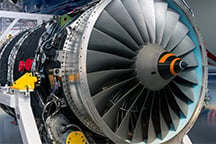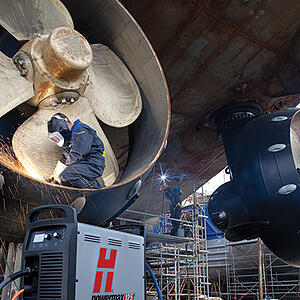Shipbuilders use industrial gases, welding mixtures and even some specialty gases in different operations for almost every stage of building and/or repairing.

Specialty gases and high purity gases also play a very important role in the aerospace industry. In aerospace the use of the right gas is often key for maximum quality and productivity when cutting and welding aluminum, titanium or other exotic materials.
Got questions? Feel free to contact us for more information.
 The shipbuilding industry faces stiff cost competition. Shipbuilders manage costs by increasing productivity and meeting high standards of quality. For example, innovations in gas-enabled welding technologies can improve quality and save significant time and money by reducing the effects of weld distortion.
The shipbuilding industry faces stiff cost competition. Shipbuilders manage costs by increasing productivity and meeting high standards of quality. For example, innovations in gas-enabled welding technologies can improve quality and save significant time and money by reducing the effects of weld distortion.
The enormous size and corrosive environment make shipbuilding a complex and costly business. Shipbuilders can manage costs by optimizing the gases and equipment used in two key disciplines:
Cutting parts requires part marking, cutting and beveling with highest possible efficiency and accuracy. Cutting block assembly panels (greater than 12 yards wide) requires large machines equipped with tools for plasma cutting, oxy-fuel cutting, grinding, beveling, high-speed text marking and automated handling of panels of different thicknesses. You can use both gas and plasma arc cutting processes for cutting parts and block assemblies.
Submerged arc welding (SAW) is a highly efficient automated welding method for welding beams and long seam on thick plate. It commonly is used in high heat and multi-pass operations. WestAir has a large range of equipment, such as carriages, welding tractors, power supplies, seam tracking and automated flux hoppers. At WestAir we have all your solutions for automated SAW welding, including Electrodes and fluxes.
Shipbuilding typically uses an unusually large number of vertical welds. And, the welded parts often require several passes because of the thickness of the parts. Fortunately, you can create reliable joints using arc welding processes (GMAW, GTAW, SMAW, SAW and plasma arc welding), depending on the actual conditions and the type of welded material.
Ship hull manufacturing requires a lot of strain-relief activities. Flame gouging, the preferred method for strain relief, removes unwanted metal by heating the metal and blowing the molten metal away. In addition, shipbuilders use special coatings to protect parts and assemblies against wear and corrosion. Thermal Arc Spraying can be done and treatments can be applied such as a hardfacing or buildup.
Regulations place strict requirements on structures manufactured by shipbuilders. Some requirements apply specifically to welds. Therefore, you need to use the highest quality materials, including industrial gases and mixtures to make sure that you comply with the relevant regulations. WestAir's trained team members will be happy to assist you with solutions to best meet your goals.
To get excellent titanium welds that look like frozen mercury; shiny and reflective, you need to consider the reactive nature of titanium. Heated in air, the titanium part surface has brittle carbides, nitrides and oxides. These can reduce the fatigue resistance and notch toughness of the weld and heat-affected zone (HAZ). Not only do you need to protect the surface being welded, you also need to protect the back side of the weld.
When cutting titanium parts, you need copper purge fixtures to direct argon over the surface of the parts. Without purges you may encounter localized alloying on the surface of titanium parts.
You also need to consider that chlorine from the perspiration on your hands can create localized corrosion. Therefore, you should use lint-free gloves after the final cleaning and before welding to achieve the highest-quality welds.
The higher thermal conductivity and low melting point of aluminum alloys can easily lead to burn-through.
Feeding aluminum welding wire during gas-metal-arc-welding (GMAW) presents a challenge because the welding wire is softer than steel, has a lower column-strength and tends to tangle at the drive roll.
Consider using argon as a shielding gas due to its cleaning action and penetration profile. A shielding-gas mixture combining argon with helium (maximum 75% helium) will minimize magnesium oxide formation.
Also, you should use a separate gun liner when welding aluminum. To prevent wire chaffing, restrain both ends of the liner to eliminate gaps between the liner and the gas diffuser on the gun. Change liners often to minimize the possibility of the abrasive aluminum oxide causing wire-feeding problems. Consider using a contact tip approximately 0.015 inches larger than the diameter of the filler metal since the tip will expand into an oval shape and possibly restrict wire feeding.